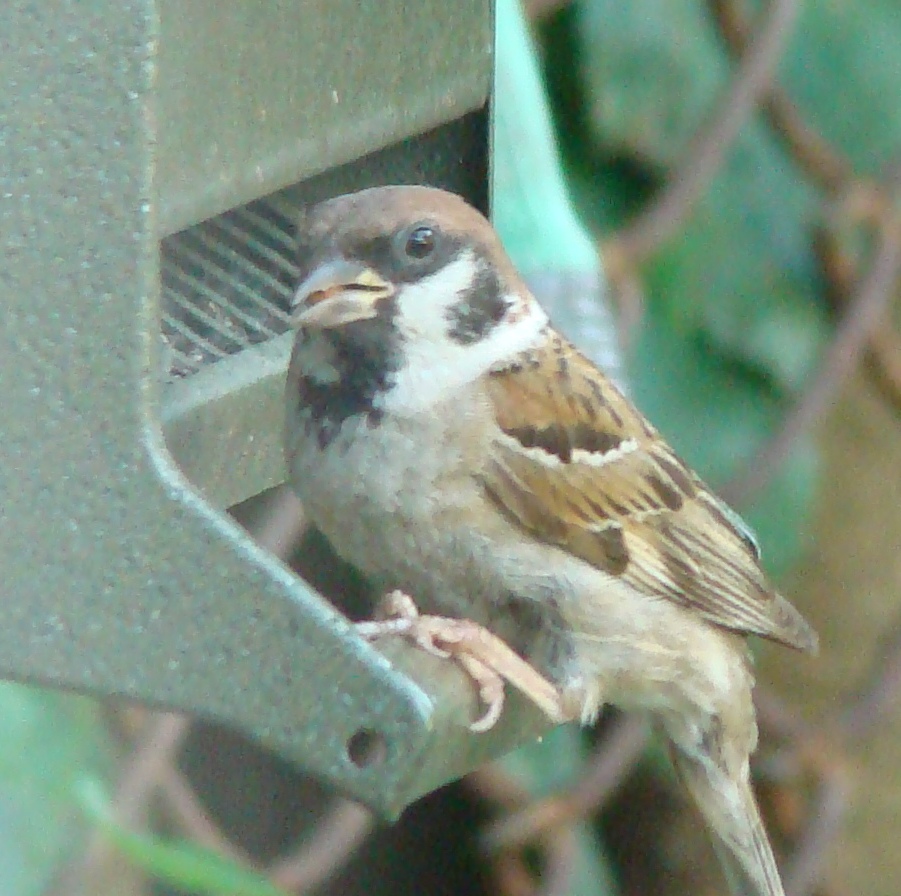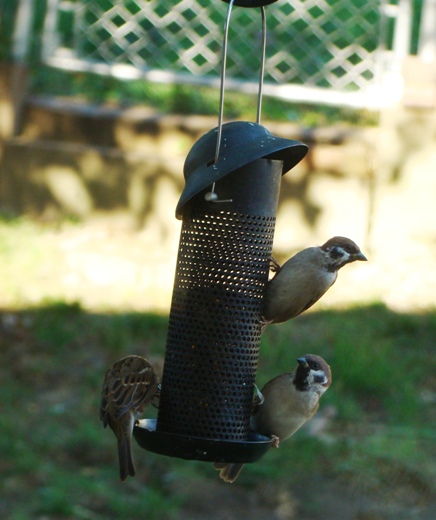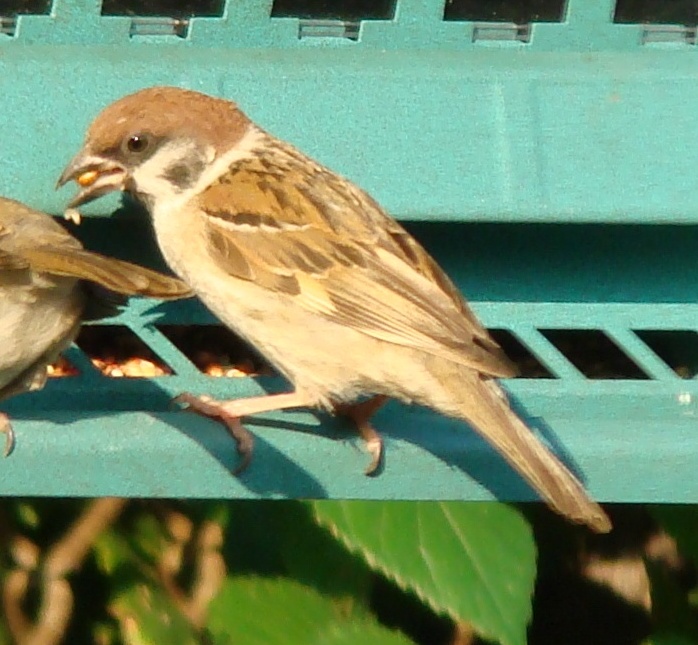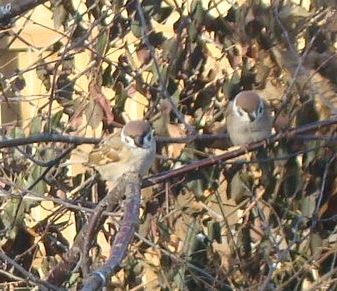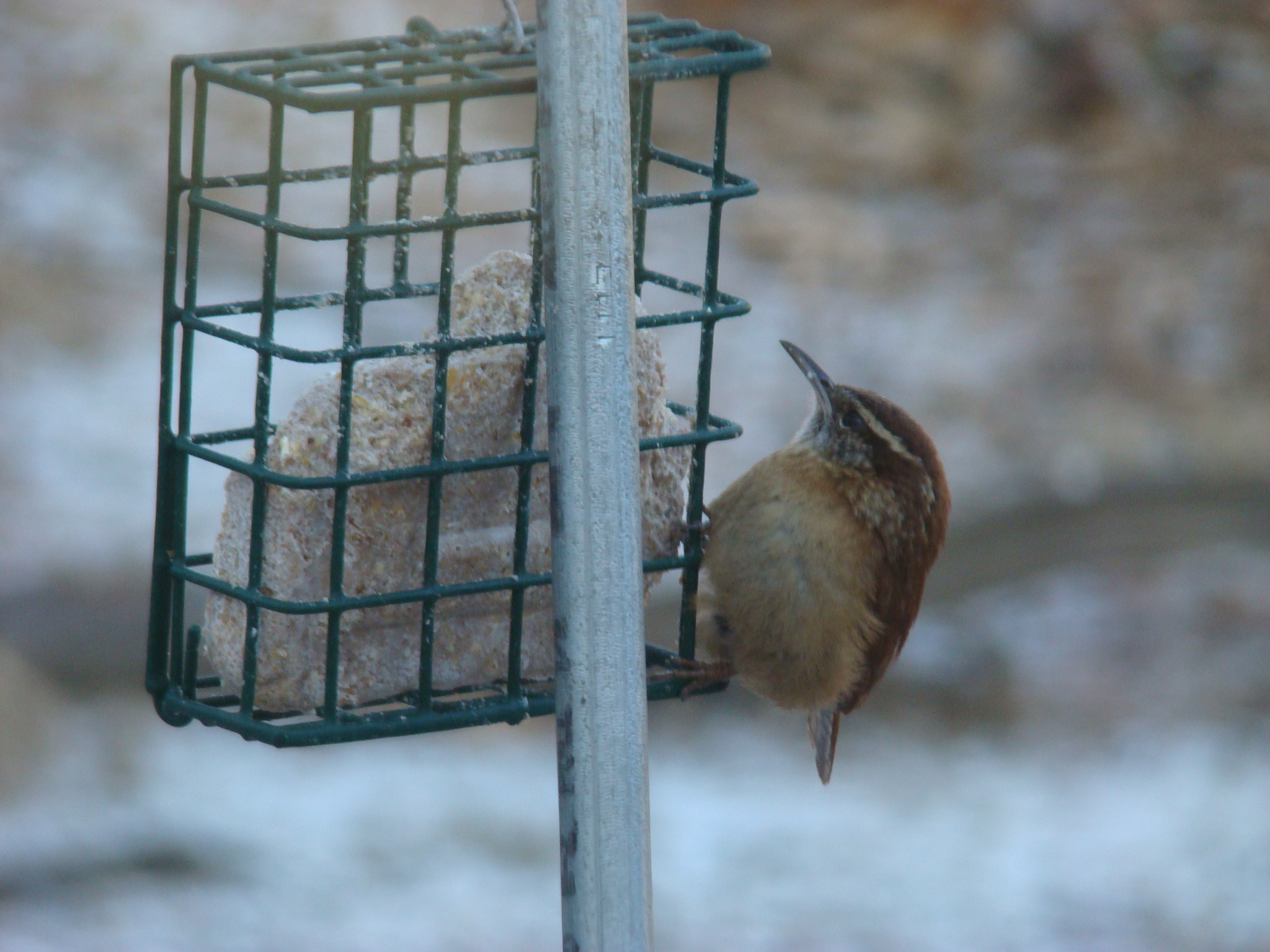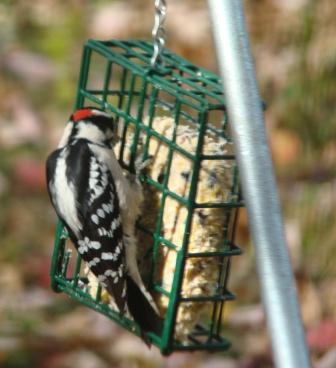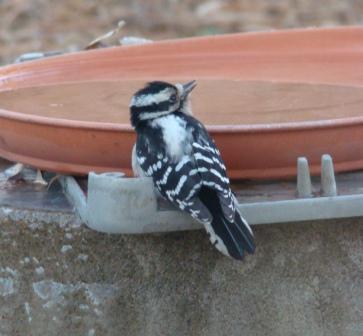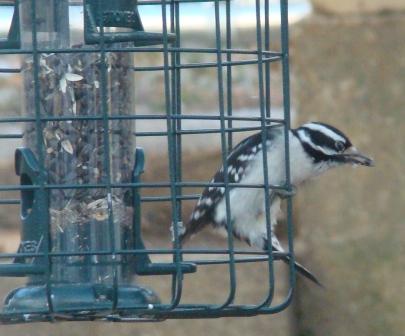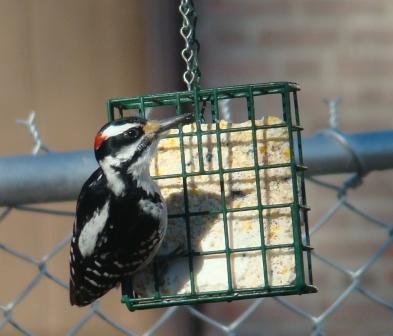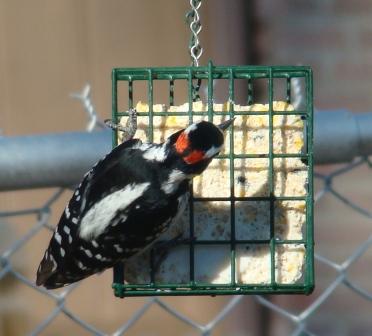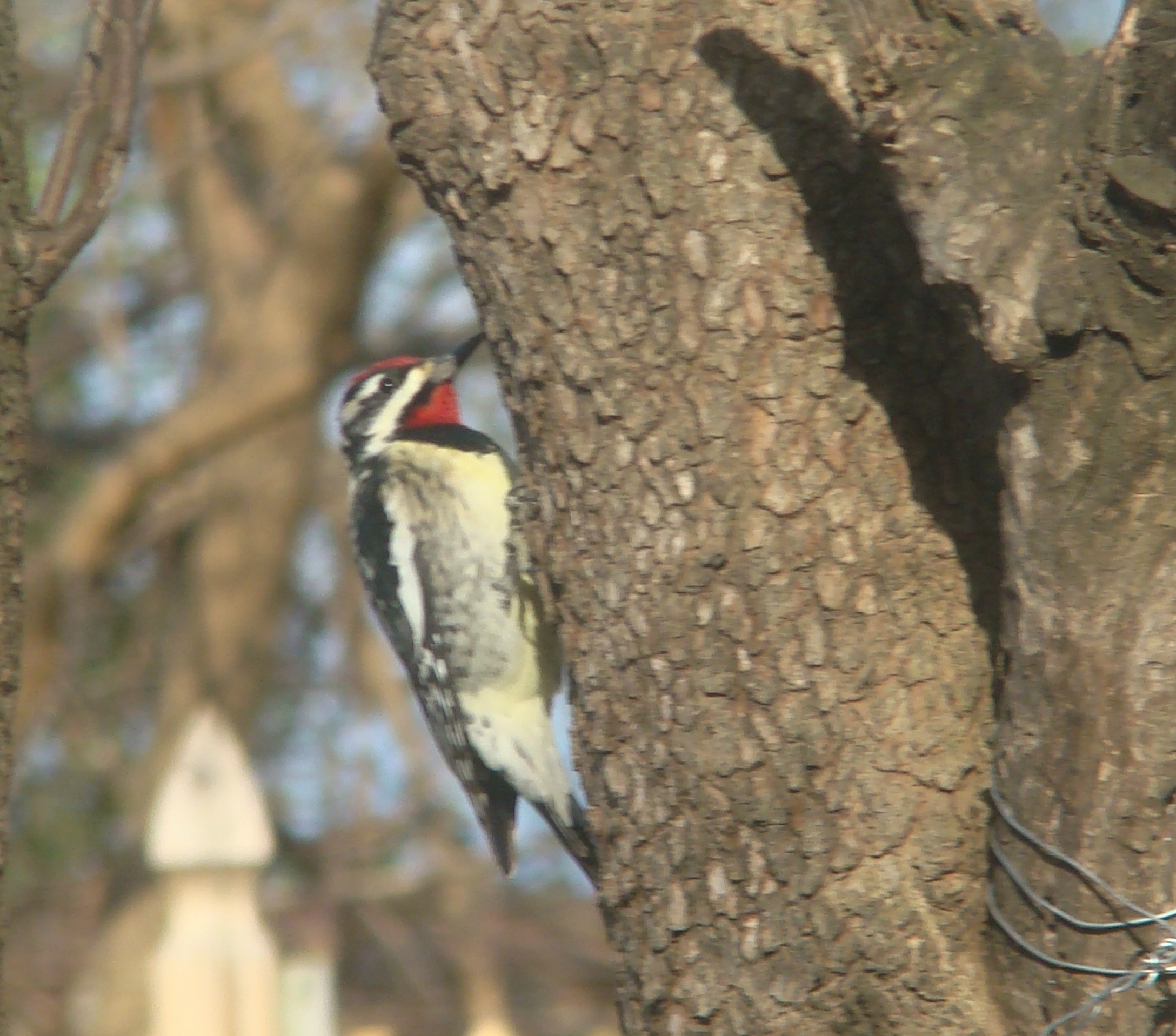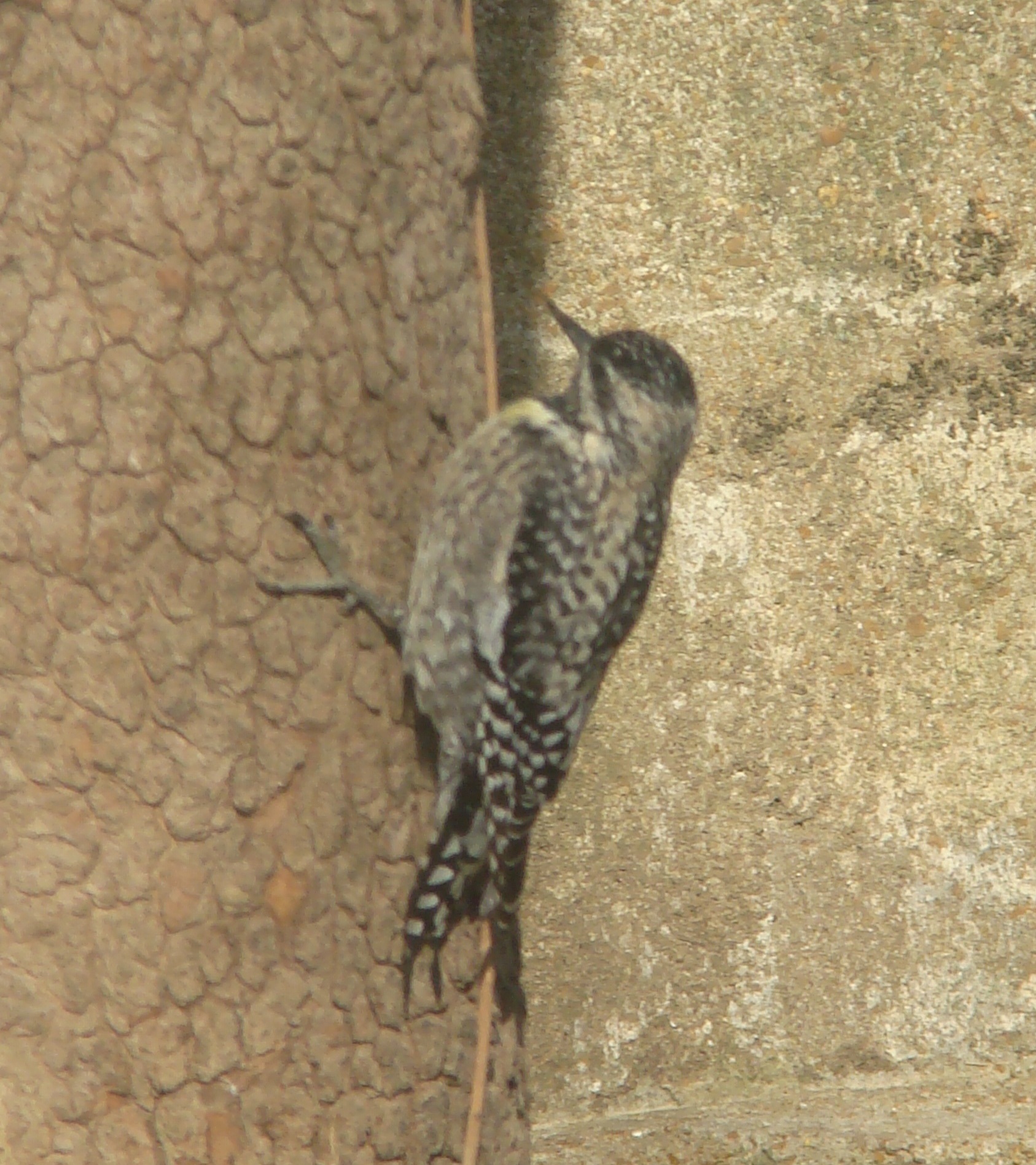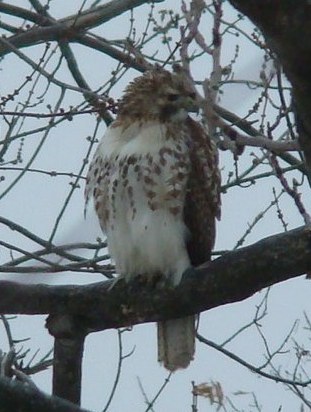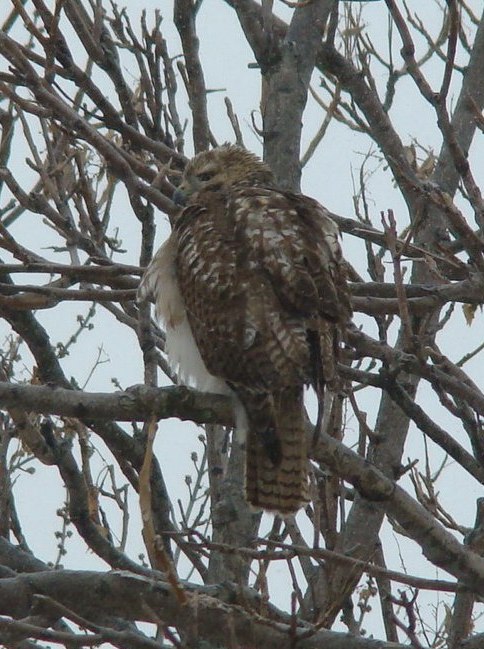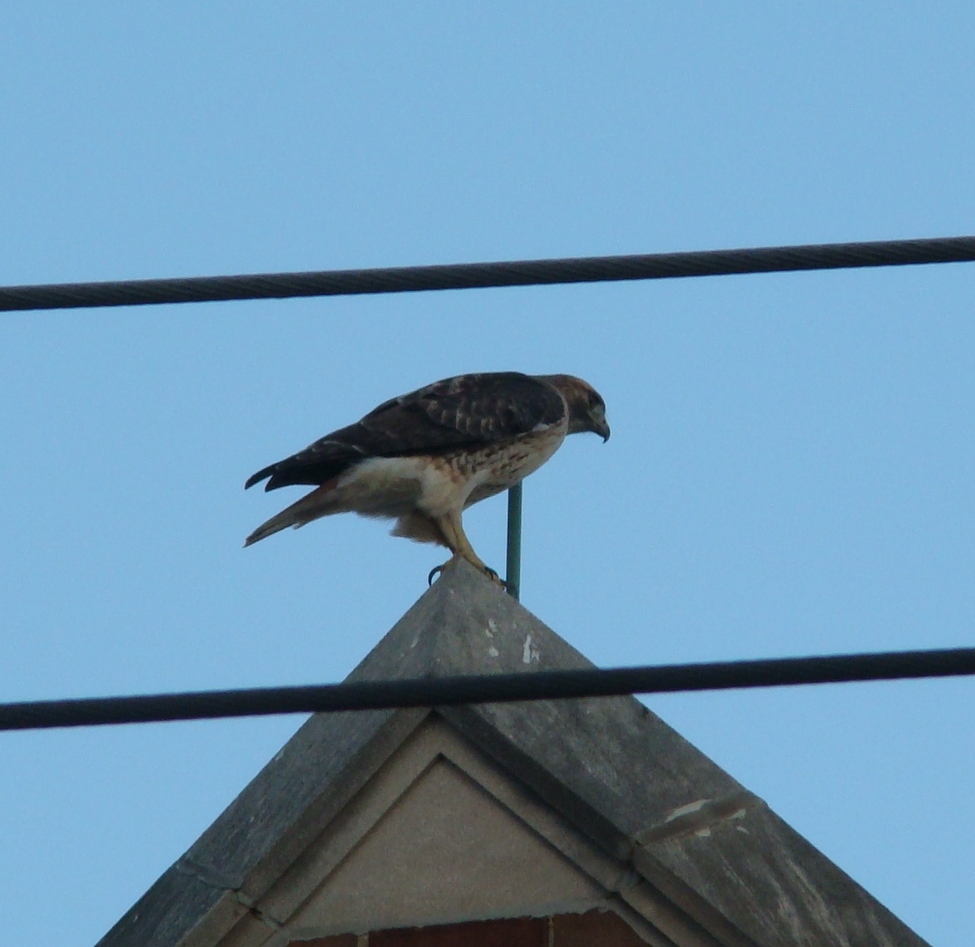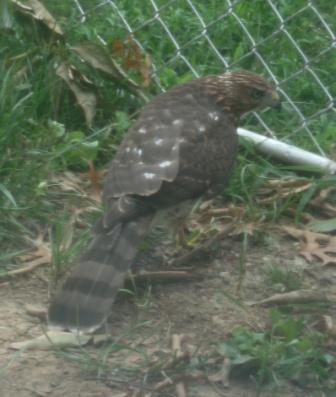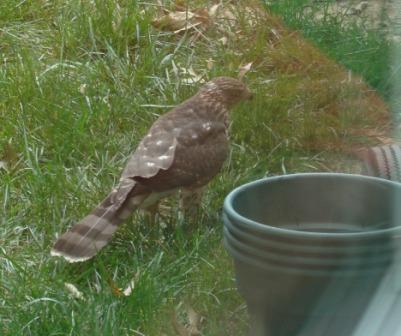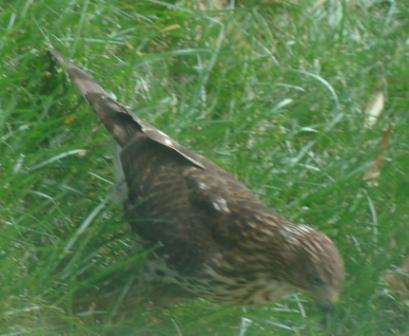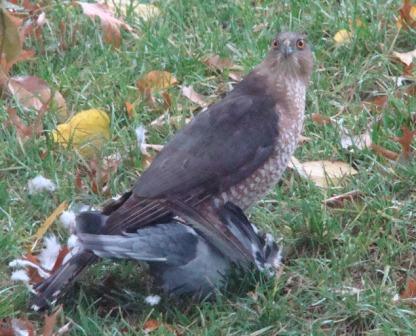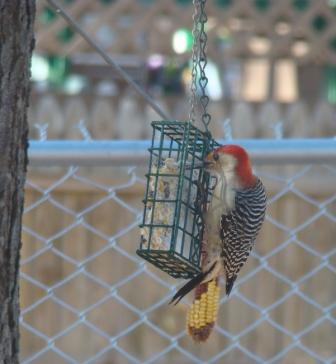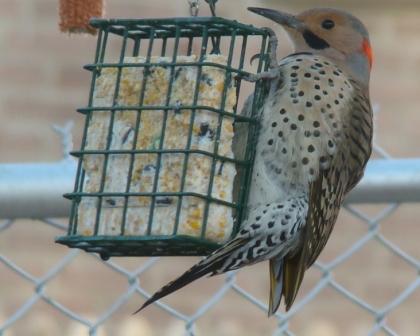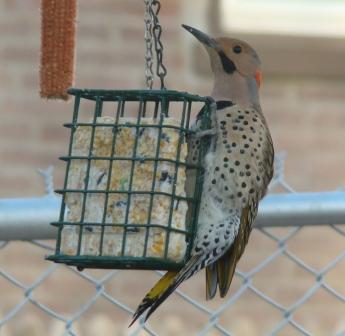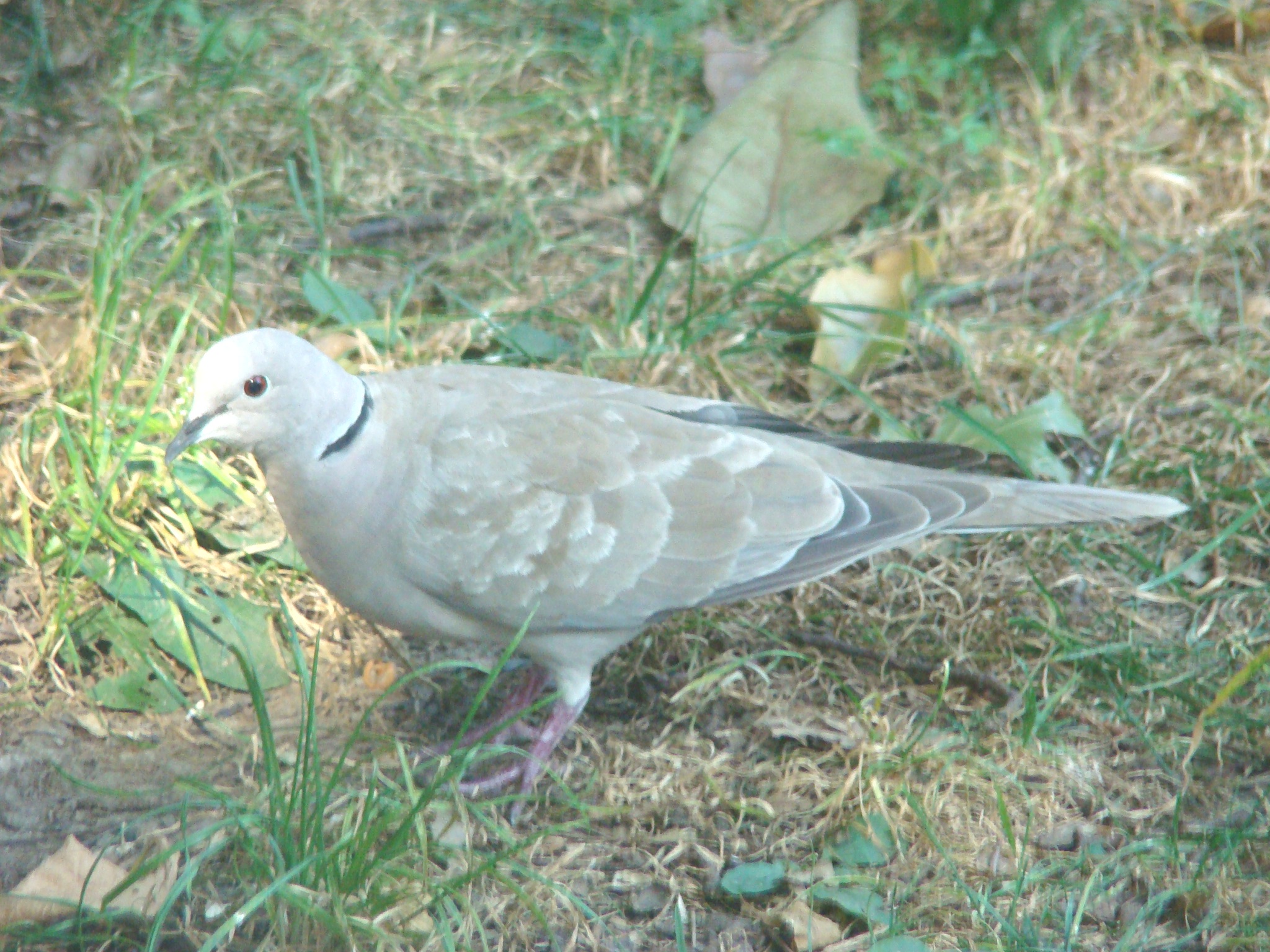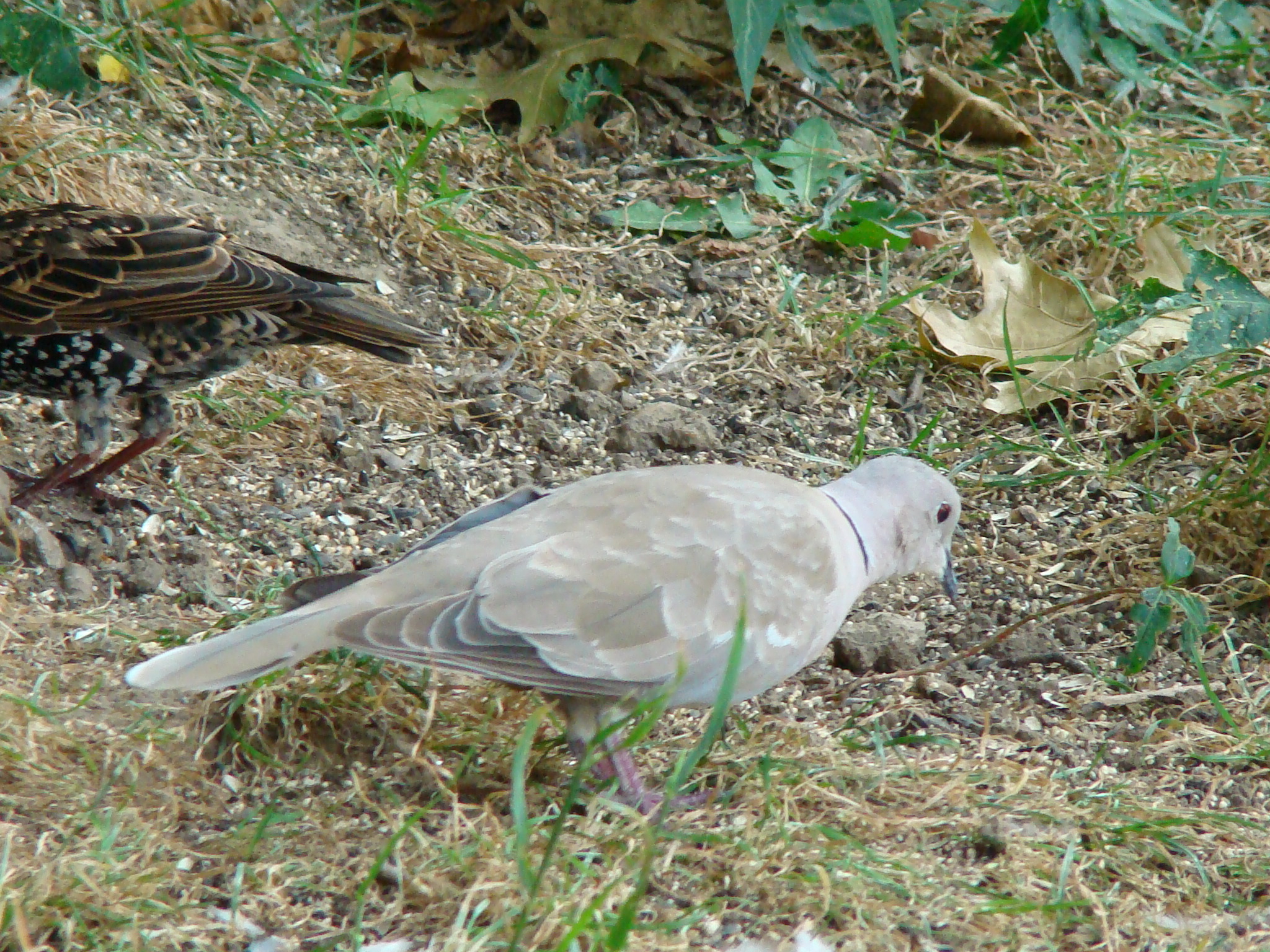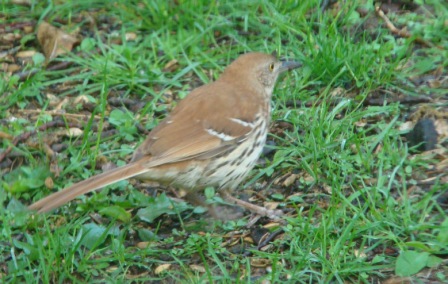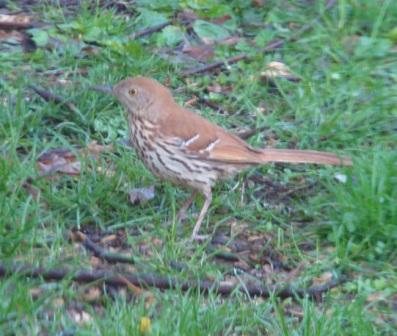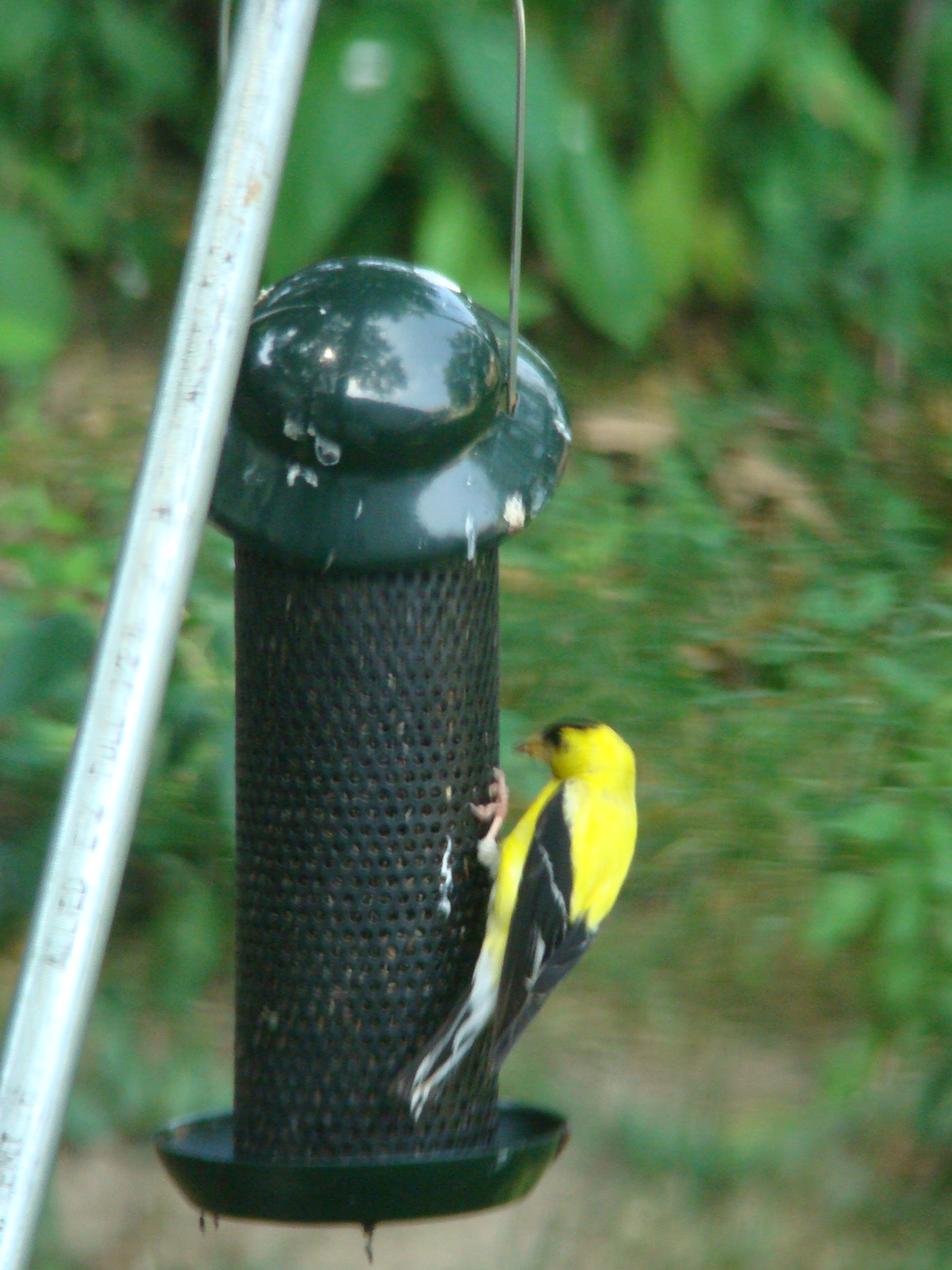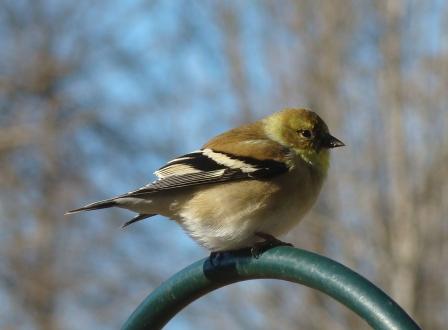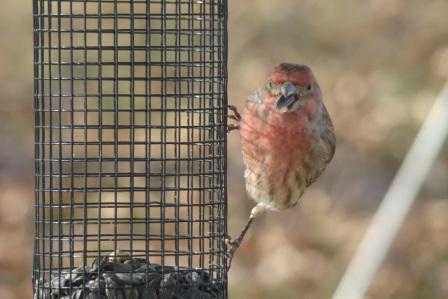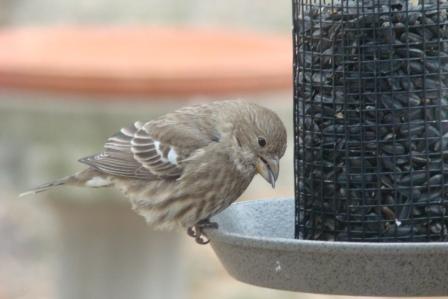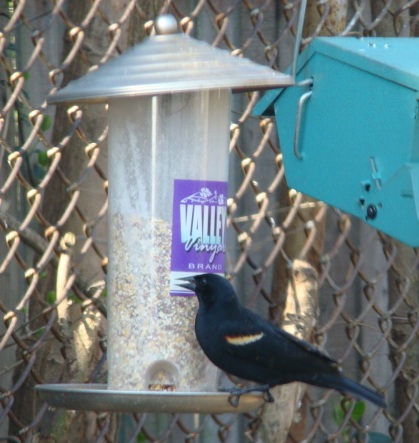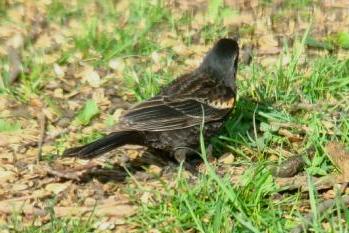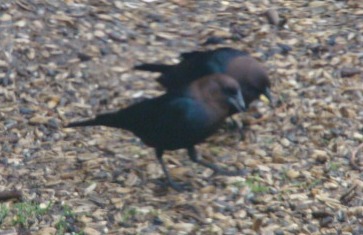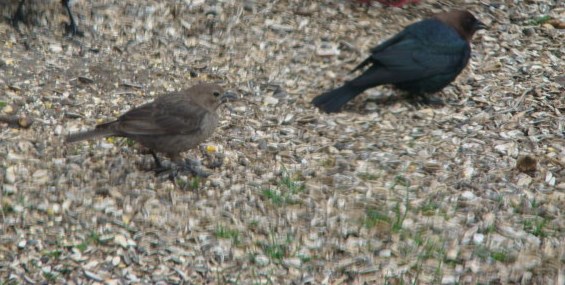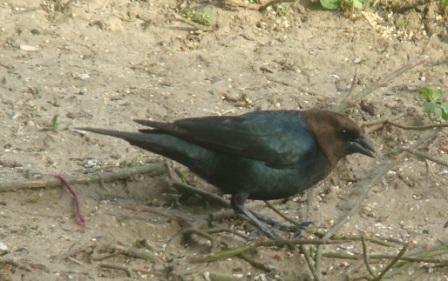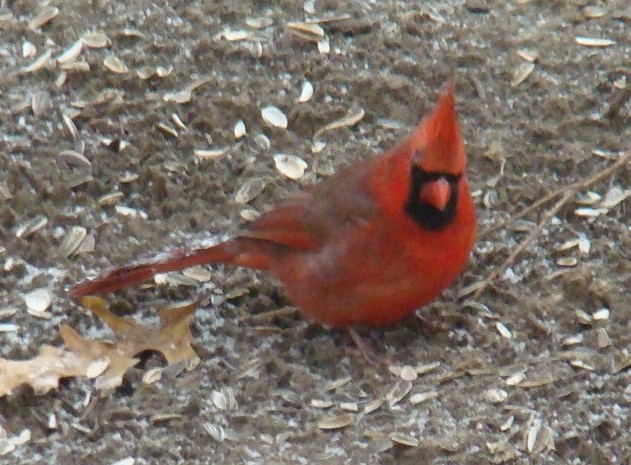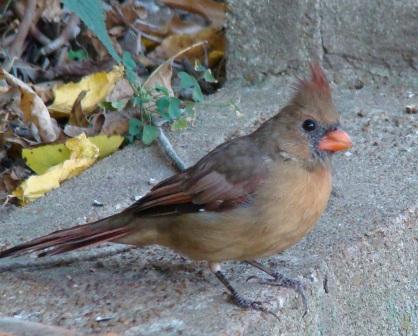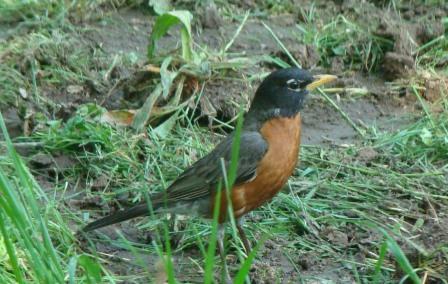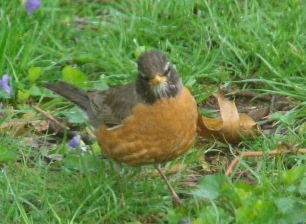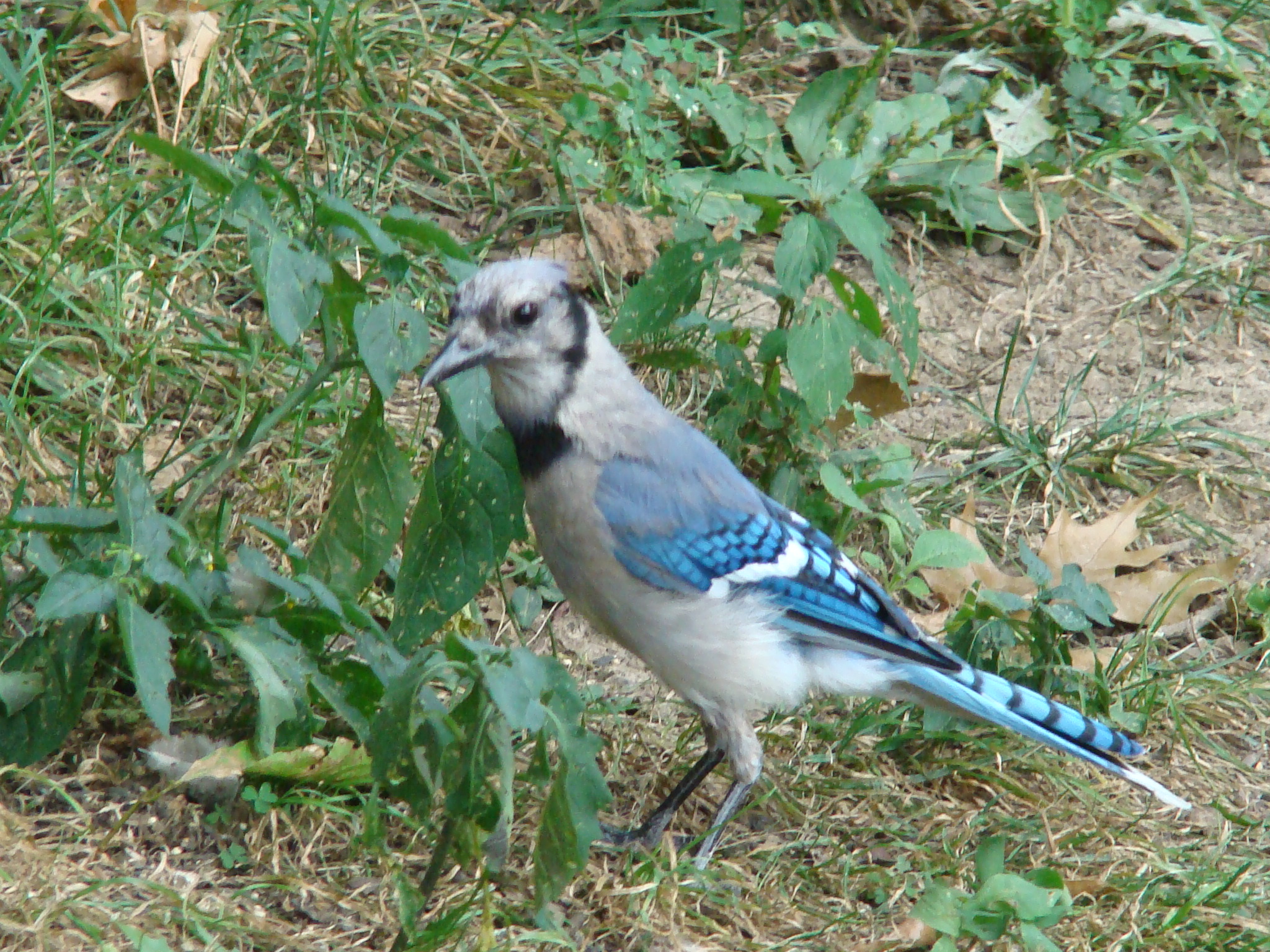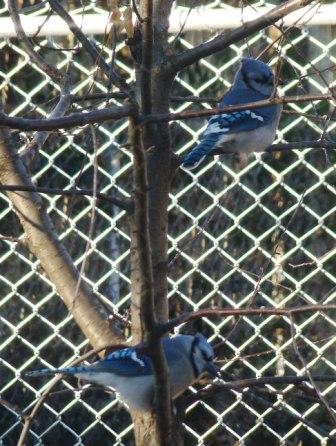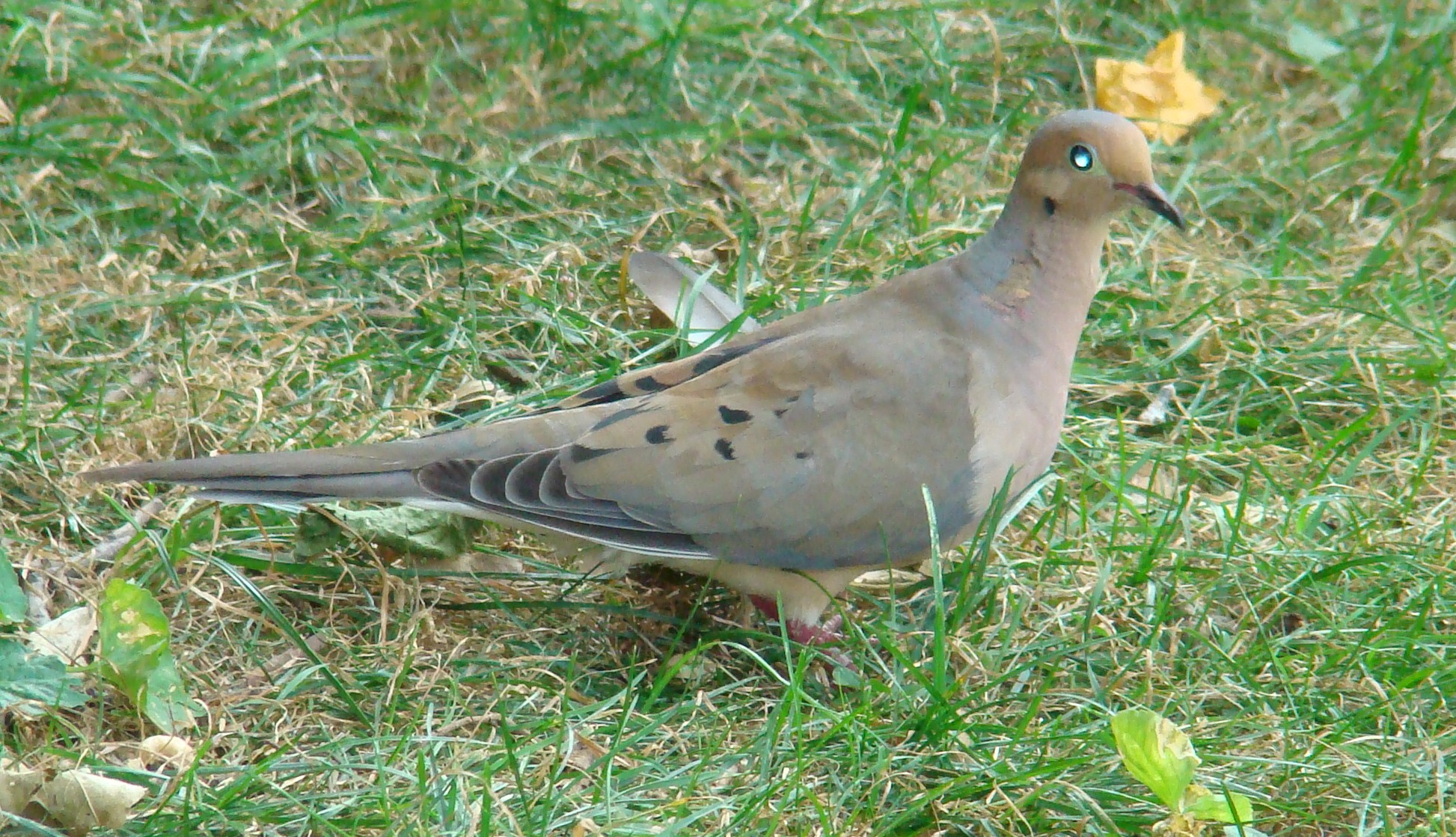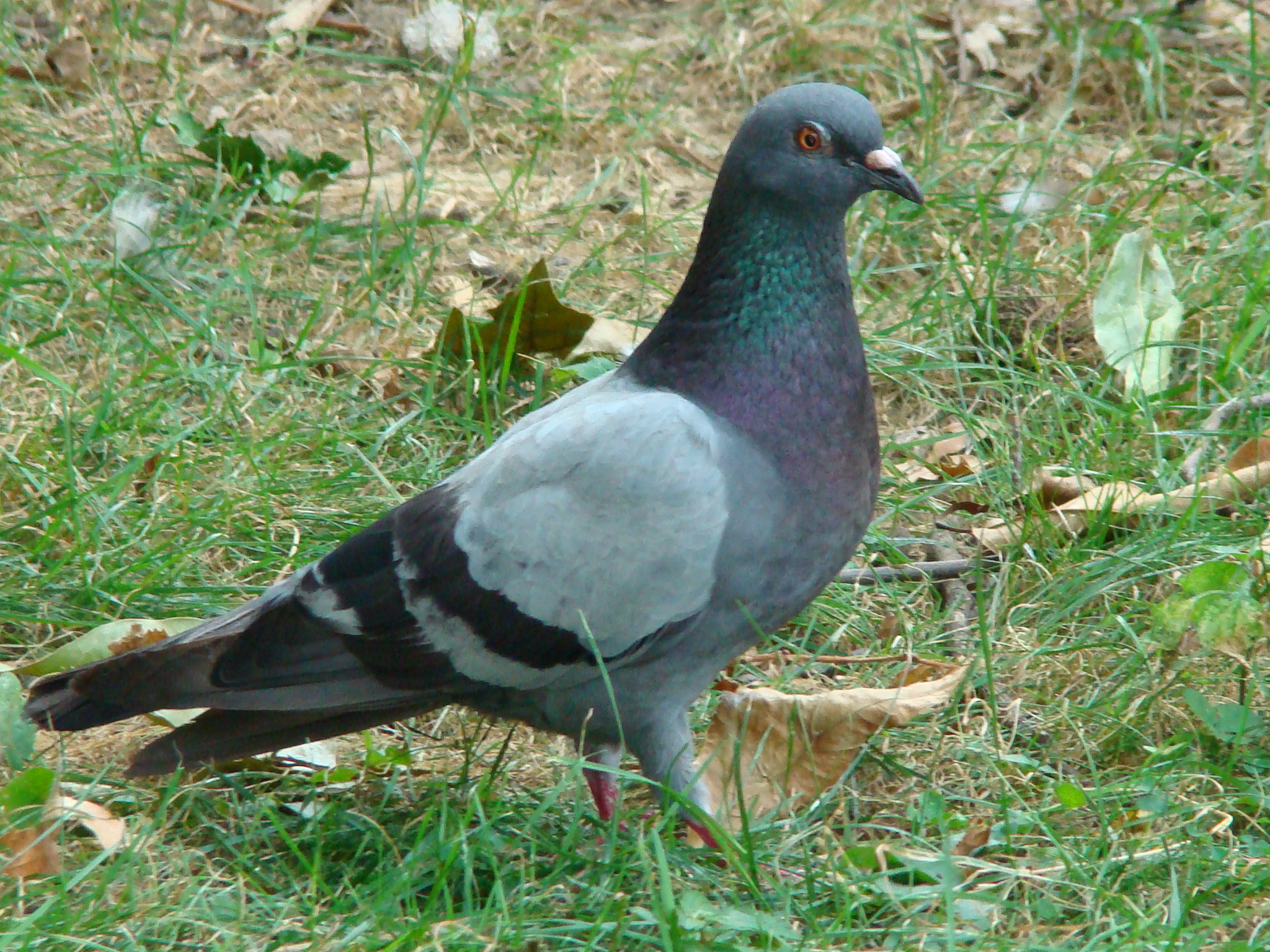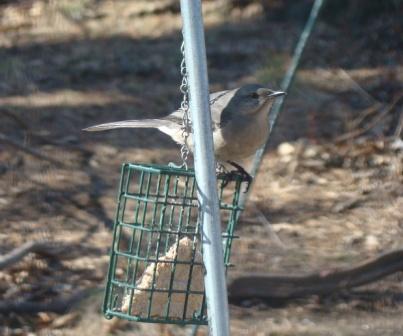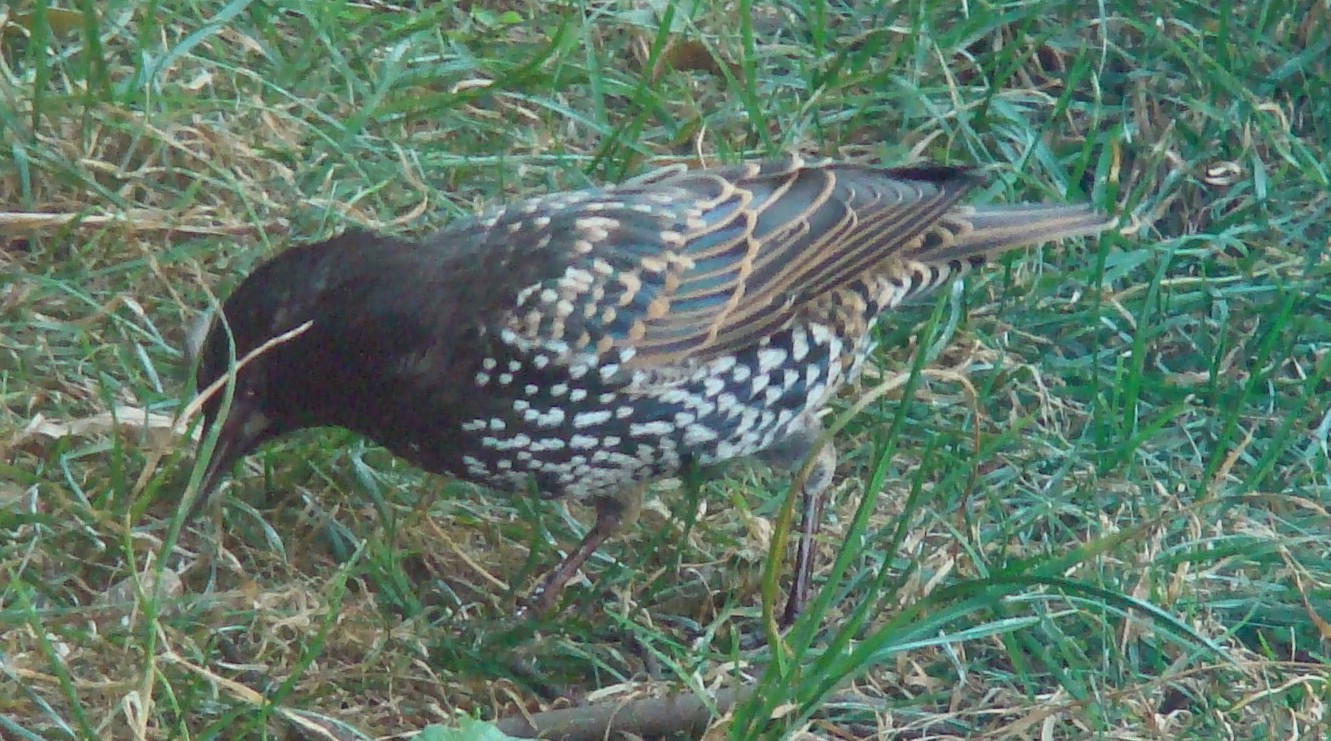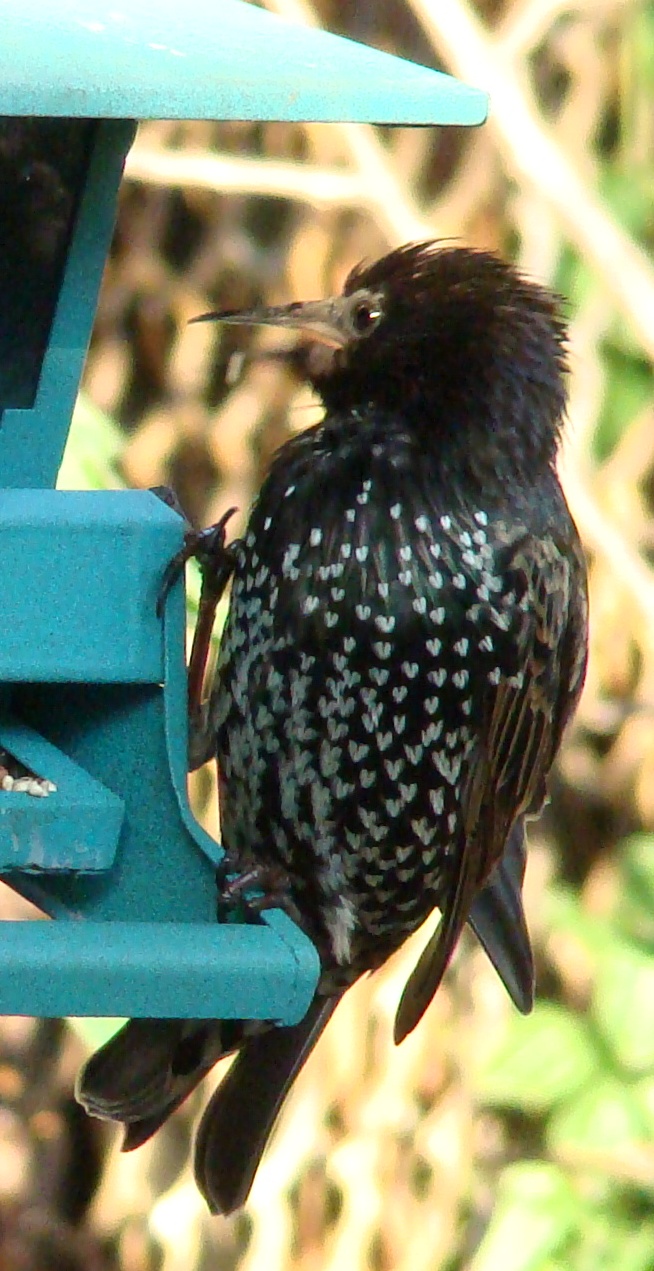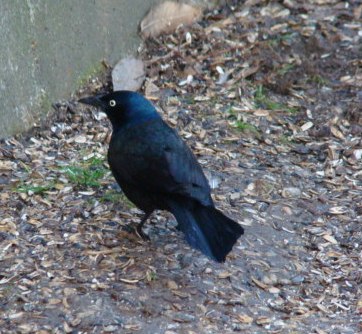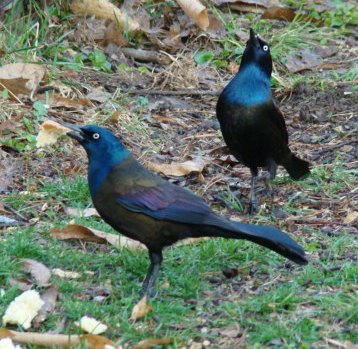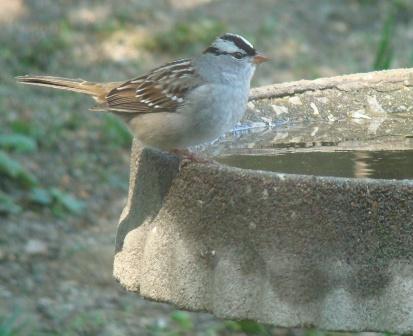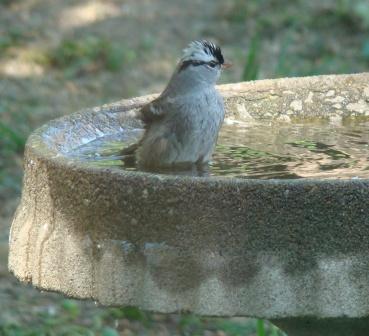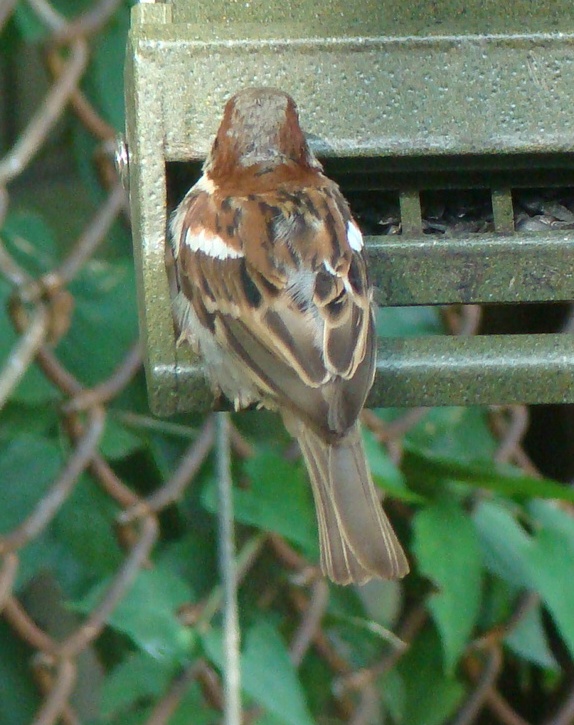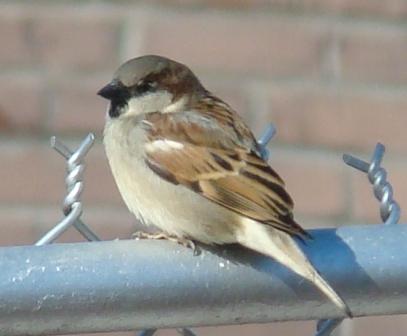The Eurasian tree sparrows are special birds which appear in
Dogtown and very few other places in St. Louis and virtually nowhere else in the U.S.
I tend to refer to them as the white-faced sparrows because of
the large white circle on the face. They have a russet head and black neck. Lovely, lovely bird.
In the book BIRDS OF ST. LOUIS AND WHERE TO FIND THEM (published in 1998 by the Webster Groves Nature Study Society) we read:
"The Eurasian Tree Sparrow is a unique resident of the St. Louis area." The book goes on to tell the story that on April 25, 1870
a group of the sparrows were released in Lafayette Park, having
been brought to the U.S. for a celebration of some German immigrants.
Later on we read: "Within the city of St. Louis, the most consistent area for finding the ETS has been southwest of Forest Park, an
area bordered roughly by Wise Avenue on the south, and a few blocks east of McCausland Avenue on the east... Curiously, they are seldom
encountered in Forest and Tower Grove Park."
Well, I can guarantee you there are a few dozen in my back yard every day of winter, and still a number of them around in the summer. They seem to live in my huge brush pile in my backyard.
I especially like the last of the four photos, in which the Eurasians are looking directly at the camera. They just look like small owls.
Photos taken by Sally Sharamitaro
August 2007 and September 2011
The Carolina wren is a now and again visitor to our yard. There is a pair that come when they come, and on the days they show up they tend to stay for a long time and
eat on every single sort of food we offer -- regular yellow wild bird seed, sunflower seeds, thistle, suet. They have such lovely coloring.
Photos taken by Sally Sharamitaro
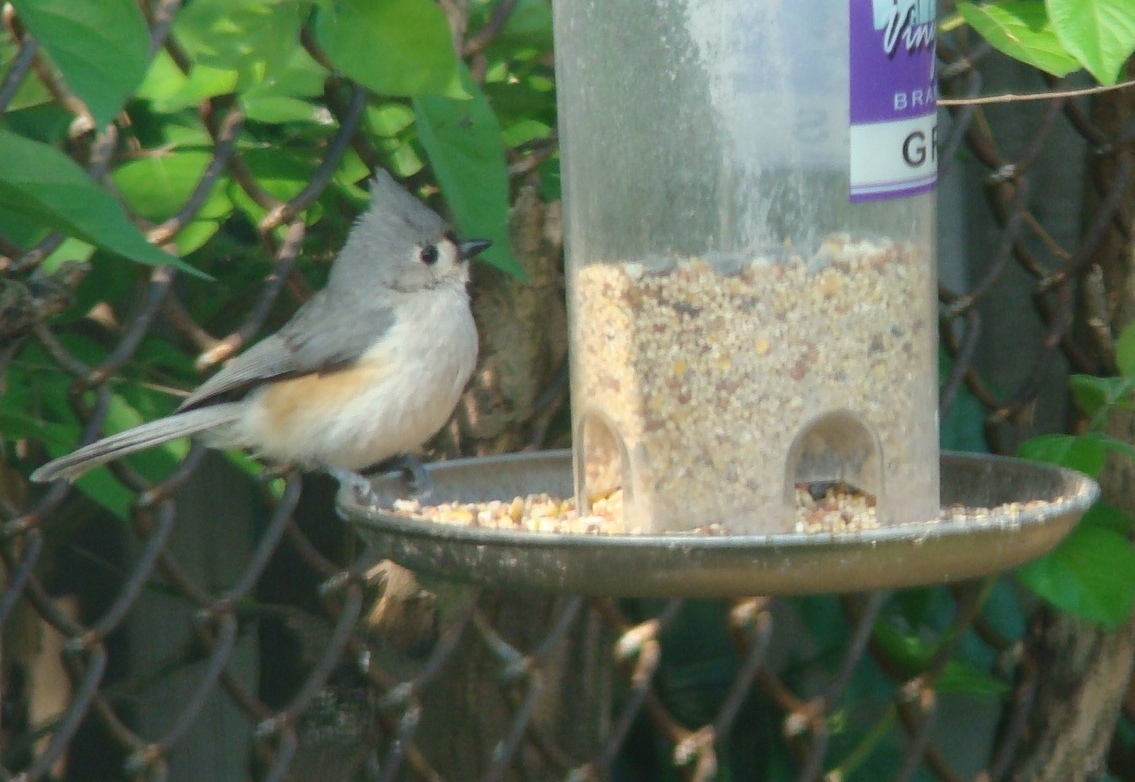
Our first visit from a tufted titmouse. Cute little nervous bird.
Photo taken by Sally Sharamitaro
April 26, 2008
| | |
The downy is a daily visitor and while it mainly likes to eat
at the suet feeder, now and again it will eat sunflower seeds. The male, on the left,
has red on the back of his head. The female, on the right, has no red.
The female is on my winter make-shift water. Since the bird bath freezes in winter,
I have a metal swing seat which I put upside down on the bird bath (which is frozen solid). Then on top of that swing seat I use this orange plastic dish, about a full
foot across. This is easy to remove and bang again a tree, breaking out the ice. I often
change the ice for fresh water two to three times a day. The birds loving having the water in winter.
In the third photo the downy had entered our new caged black sunflower seed feeder. We use this (successfully!) to combat the squirrels. The downy is the only "larger" bird that will go in it. The house finches and goldfinches and dark-eyed junkos go in the feeder all the time. The cardinals and other larger birds don't. But, the downy does, but prefers some of our other open feeders.
Photos taken by Sally Sharamitaro
The first was taken in 2008 and the other two in January 2009.
HAIRY WOODPECKER
Very scarce visitor, but twice this week in January 2009. The bird looks almost identical to the downy woodpecker except for size. The hairy woodpecker is much larger, and especially the beak. The beak of a downy woodpecker looks like a sharp, slim
ice-pick. The beak of the hairy woodpecker is much more like a screw driver!
I see the hairy woodpeckers with some frequency in the Kennedy Forest part of Forest Park, but very seldom in my back yard.
Photos taken by Sally Sharamitaro
January 2009
YELLOW-BELLIED SAPSUCKER
Seemingly a migrating bird, came on April 2, 2009. Two of them spent a long time in our
yard pecking at our dogwood tree.
Photos taken by Sally Sharamitaro
January 2009
RED-TAIL HAWK
In 2006-07 there was an occasional visit from a hawk. Now, this red-tail seems
to have taken up residence close by and is here every day. I believe it is a young
hawk, and not very skilled in hunting. A few days ago there were more than 20, perhaps even 30, mourning doves feeding on the ground in a very small space. The hawk roared in,
landing in the middle of the doves and didn't get a single one! I was sitting about
10 foot away at my window (of course without the camera), and was astonished at his
failure to get breakfast.
The hawk often sits on a branch in our neighbor's yard, sometimes for long periods of time.
Top two photos taken by Sally Sharamitaro
December 2008
The bottom two were taken on election day, 2008. The flying hawk is over the top
of St. James School and the second has the hawk sitting on the peak of St. James
School. Both were taken by Sally from our new front porch.
| | |
This hawk, or one like it, has been coming to our area for the past couple years. But this was the first time it ever landed in the yard. We were eating out mid-day meal and the birds in the yard took off like crazy, often a sign of a hawk. About a minute lady Sally shouted to me, "Look, look, look." (Pointing). It was about
3-4 feet from my chair right outside the window. She hurried to get her camera, and got these three photos, but it was difficult and two of them were taken through a screen door. The hawk stayed at least 5 minutes in the yard looking for something to eat, even investigating our trash can.
The third photo, while not very clear, does give some view of the sort of mottled breast of the bird.
The first three photos taken by Sally Sharamitaro in August 2009.
The more grusome photo was taken in Nov. 2009 when the hawk, for the third or fourth day in a row, got a rock dove in our backyard.
RED-BELLIED WOODPECKER
Frequent visitor, eats on suet, but like sunflower seeds and even ground feeds with the doves and others. The corn next to the woodpecker is actually on pinwheel which is
attached to a tree and is for the squirrels.
Photos taken by Sally Sharamitaro
December 2008
NORTHERN FLICKER
Flicker, as we call it, is one of our favorite birds. A quite large woodpecker,
nearly twice the size of a downy woodpecker, comes often but not daily. It will sometimes ground feed on what it digs up, at times in one of our trees, drilling here or there,
and very often also at one of our suet feeders. Very lovely bird.
The upper left flicker is the female. The bottom two are the male. Note the
black oval on the face of the male flicker.
The two flickers, male and female are sitting on the roof of our back door neighbor's house.
Photos taken by Sally Sharamitaro
December 2008
| | |
| This lovely bird which we have nick-named "The Queen" first
showed up in the very cold of winter. At that time the color was
much more pure white than this late summer photo. It wasn't a
daily visitor, but came quite often all winter long |
| I added this second photo to help with the identification. The Eurasian collared dove is not even list in the famous Peterson guide.
However, it is in Selby's guide. Note the darkness of the wing
feathers. This seems to be a key difference of this bird from
the ringed turtle-dove.
|
Photos taken by Sally Sharamitaro

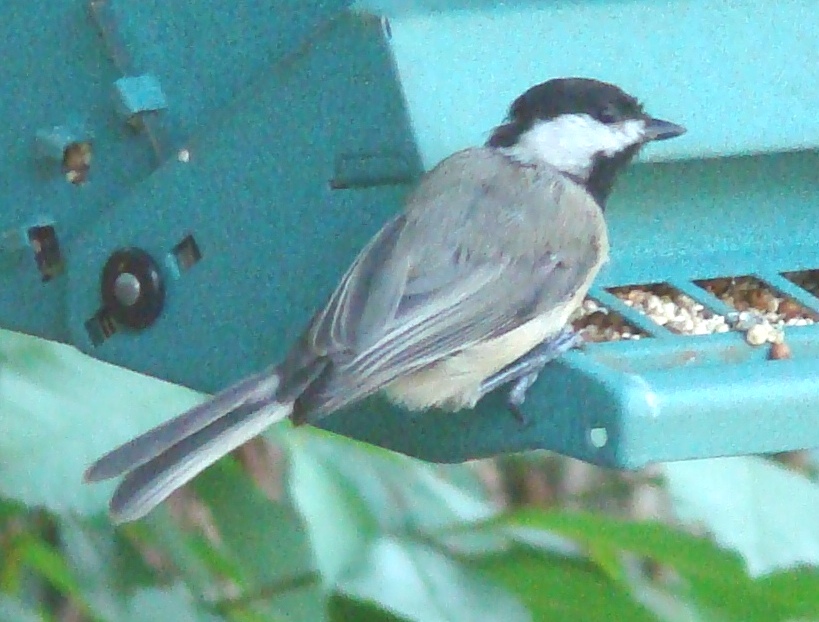
The bird tends to sit in the chain-line fence a couple feet from a
sunflower seed feeder. Then it rushes to the feeder, grabs a
seed and moves back to the fence to eat. It seems to like the greater "cover" of the fence. It then holds the seed in its claw and
eats it from the claw.
The first chickadee I've seen in my yard came just
a few days ago, mid-August 2007.
This is another bird where I have revised my original
identification. I thought it was a black-capped chickadee. Shawn
Clubb, a much more experienced bird watcher than I suggests it
is actually more likely to be a Carolina chickadee, and I have
decided to go with that identification for a while. It is a very
new arrival to my yard, less than a week ago, and it seems there are
two of them who drop by almost every day in the late afternoon.
I'll try to watch them more carefully and get further photos of this
bird.
Photos taken by Sally Sharamitaro
August 2007
| | |
| | |
| BROWN THRASHER
April, 2008
| SAME BROWN THRASHER
April 2008
|
Photos taken by Sally Sharamitaro
MALE GOLDFINCH -- SUMMER AND WINTER COLORS
August, 2007
One of our favorite and most colorful daily visitors is
the goldfinch. Here is the bright yellow of the summer male
and another of the male in the duller winter colors..
The bird's favorite feeder is a thistle feeder, but the winter bird
is on a black sunflower feeder.
First bird photo taken by Bob Corbett which I've mounted
to my web page in April 2008
The second photo was taken by Sally Sharamitaro on New Year's Eve, 2008.
HOUSE FINCHES
The male house finch (on left) seems to me an often wrongly identified
as a purple finch. I have only seen one purple finch in my yard and one in Forest Park, but there are dozens and dozens of this bird,
the house finch.
| | |
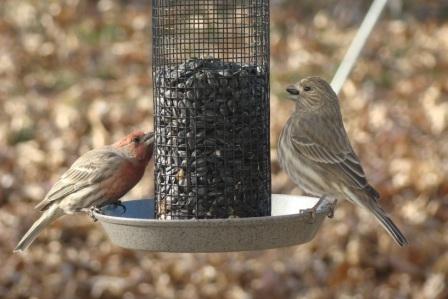 |
| 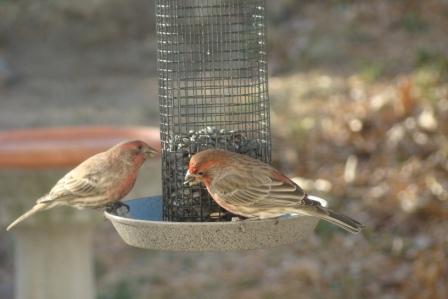 |
HOUSE FINCHES IN GROUPS
December 2010
This photo from December 2010 is of a feeder about 3 foot from
our sitting room window. I've seen as many a 6 finches on this
feeder at the same time. The female (on the left) is less colorful than
the male, but has lovely shades of brown. They love black sunflower seeds.
Photos taken by Sally Sharamitaro
December 2010
| | |
| | |
| MALE REDWING BLACKBIRD
April, 2008
Loves sunflower seeds and will ground feed as well.
| FEMALE REDWND BLACKBIRD
April 2008
|
Photos taken by Sally Sharamitaro
The brown-headed cowbirds are often with the redwing black birds and the starlings. They don't come as often as either of the other, but eat the same
things as they, generally ground feeding
In the second photo one notes the male is black with the brown head, but the
female is more totally brown and tan.
Photos taken by Sally Sharamitaro
March 2008
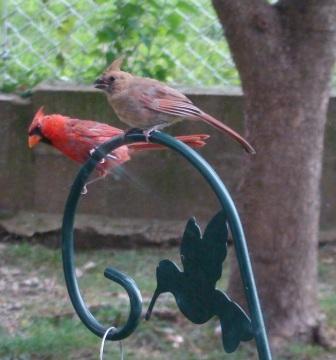 |
| 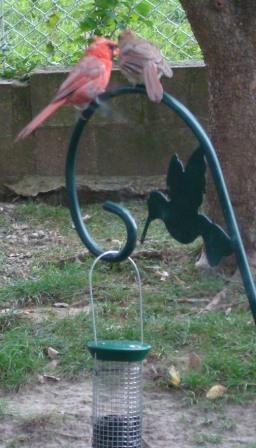 |
CARDINAL
The cardinals are the only birds that regularly come to the feeders even before
the first light of day. One neighbor out back has a bright back porch light and
I can often see the robins feeding at 4:30 - 5 AM in the morning. They like the
sunflower seed best but will eat wild bird seed as well.
Top two photos taken by Sally Sharamitaro in 2008
Bottom two were taken by her in Aug. 2009
The male robin is on the left and is a stronger black. The female, on the right, is more a tan than black back
The robins seldom eat anything in the yard, but do love the fresh water and
take big splashy bathes all the time. In the heart of winter they do learn to
eat the suet.
Photos taken by Sally Sharamitaro
April 2008
BLUE JAY
August, 2007
The blue jay is a daily visitor and likes it a great deal in
winter when we put out peanuts in the shell. It will make several
trips to the peanut bucket, take one, head to a tree and hold the
nut in its claw while it breaks it open with its beak.
Photos taken by Sally Sharamitaro
Single jay taken in 2007, pair in December 2008
MOURNING DOVE AND ROCK DOVE
August, 2007
These birds are constant visitors and both are ground feeders.
Now and again, but not often they will visit a feeder.
Photos taken by Sally Sharamitaro
| | |
MOCKINGBIRD
The mockingbirds actually live in the front yard and don't come back to the back
yard very often. In colder winter they come and eat at the suet feeder, and in all seasons they do come to the back yard for water from the bird bath.
Photos taken by Sally Sharamitaro
March 2008
| | |
| | |
STARLINGS (ADULT ON LEFT -- YOUNG IN SUMMER ON RIGHT
The starlings aren't my favorite visitors, but there are daily, that's for sure. Note that in summer the young take on strong spots
on the breast and some different coloring.
Photos taken by Sally Sharamitaro
August 2007
COMMON GRACKLE
These birds were daily visitors in much of 2007, but haven't been around
much in 2008. When here they are much like the starlings, feeding on almost ANYTHING.
Seed of all kinds, even the suet, and any food scraps from bread, left over meat and vegetables, nearly anything we put out.
Photo taken by Sally Sharamitaro
Summer 2008
WHITE-THROAT SPARROW
Daily visitors in winter, and one of the birds I find the most lovely of all who
visit. There are generally at least 4-6 of them around each day and they are mainly
ground feeders, getting seed dropped by other birds from feeders or suet cages. Now and again they do feed at the yellow wild bird seed feeder, but mainly they are ground feeders. They don't eat bread or any other "human" left overs.
Photos taken by Sally Sharamitaro (left side, December 2010, on right side,
December 2008
WHITE-CROWNED SPARROW
The white-crowned do not reside in my yard, nor do I think they reside in our area. However, even year I get some visits from them in the spring and fall as they are
moving either south or north, given the season.
The two photos Sally got of the same bird have delighted me. A "before and after" the bath photo. I simply love the second of the two, but the first gives a great
idea of what the bird looks like normally.
Photos taken by Sally Sharamitaro
Fall 2009
HOUSE SPARROW
Daily visitors who like the general yellowish wild bird seed. The male is on the
left and the female on the right.
Photos taken by Sally Sharamitaro
Males on top row -- August 2008 and January 2009
Females on bottom row -- January 2009 and December 2010
Also known as "snow bird"
 |
| 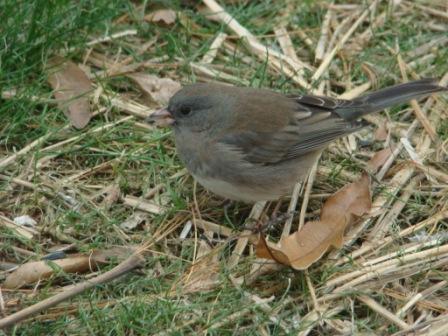 |
DARK-EYE JUNKO
The male is pictured on the left and the female on the right.
Junkos arrive in late October and are daily visitors, often in significant number,
until warm weather in the spring.
Photos taken by Sally Sharamitaro
August 2008 and December 2008
 |
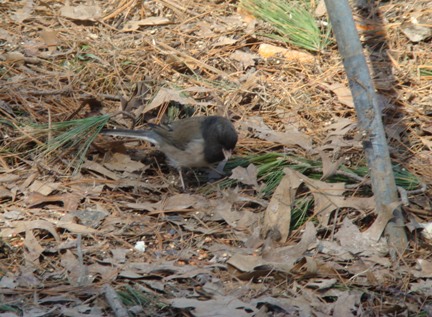 |
|
OREGON JUNKO
This bird was first spotted in our back yard in March 2013. The photo on the left with the robin is intended to show the size of this new visitor.
Unlike the Dark eyed Junkos that arrive here every October and are daily visitors till spring, the Silby Field Guide to Birds of Eastern North America says of the Oregon Junko: "Uncommon winter visitor along western edge of eastern North America; rare visitor farther east.".
Both Photos taken by Sally Sharamitaro in March 2013
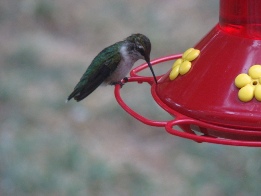 |
|  |
HUMMINGBIRDS
We decided in late summer 2011 to try out a new hummingbird feeder.
And we were utterly delighted to see that it attracted several hummingbirds.
Both Photos taken by Sally Sharamitaro in August 2011
HOME
Bob Corbett bob@corbettland.com
